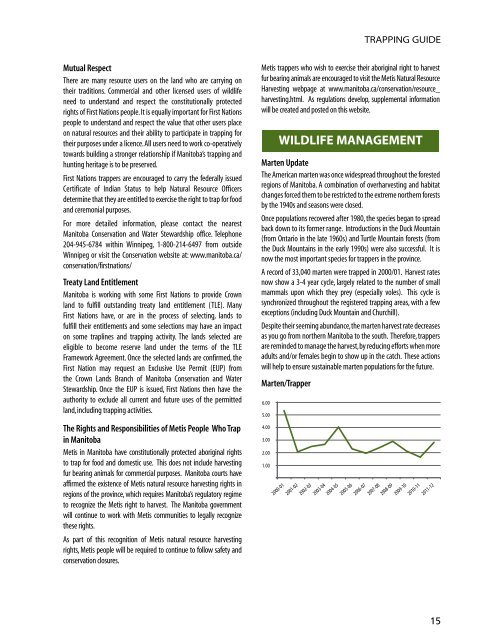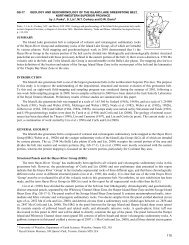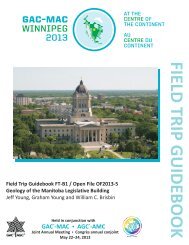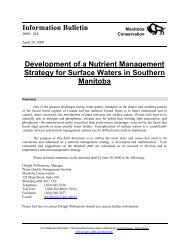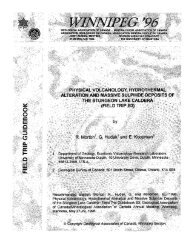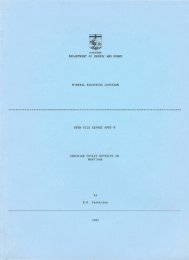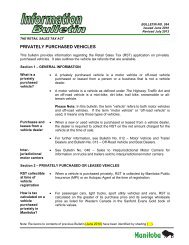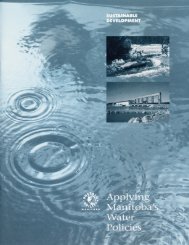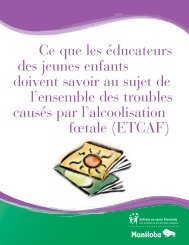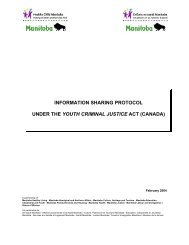Trapping Guide - Government of Manitoba
Trapping Guide - Government of Manitoba
Trapping Guide - Government of Manitoba
Create successful ePaper yourself
Turn your PDF publications into a flip-book with our unique Google optimized e-Paper software.
TRAPPING GUIDEMutual RespectThere are many resource users on the land who are carrying ontheir traditions. Commercial and other licensed users <strong>of</strong> wildlifeneed to understand and respect the constitutionally protectedrights <strong>of</strong> First Nations people. It is equally important for First Nationspeople to understand and respect the value that other users placeon natural resources and their ability to participate in trapping fortheir purposes under a licence. All users need to work co-operativelytowards building a stronger relationship if <strong>Manitoba</strong>’s trapping andhunting heritage is to be preserved.First Nations trappers are encouraged to carry the federally issuedCertificate <strong>of</strong> Indian Status to help Natural Resource Officersdetermine that they are entitled to exercise the right to trap for foodand ceremonial purposes.For more detailed information, please contact the nearest<strong>Manitoba</strong> Conservation and Water Stewardship <strong>of</strong>fice. Telephone204-945-6784 within Winnipeg, 1-800-214-6497 from outsideWinnipeg or visit the Conservation website at: www.manitoba.ca/conservation/firstnations/Treaty Land Entitlement<strong>Manitoba</strong> is working with some First Nations to provide Crownland to fulfill outstanding treaty land entitlement (TLE). ManyFirst Nations have, or are in the process <strong>of</strong> selecting, lands t<strong>of</strong>ulfill their entitlements and some selections may have an impacton some traplines and trapping activity. The lands selected areeligible to become reserve land under the terms <strong>of</strong> the TLEFramework Agreement. Once the selected lands are confirmed, theFirst Nation may request an Exclusive Use Permit (EUP) fromthe Crown Lands Branch <strong>of</strong> <strong>Manitoba</strong> Conservation and WaterStewardship. Once the EUP is issued, First Nations then have theauthority to exclude all current and future uses <strong>of</strong> the permittedland, including trapping activities.The Rights and Responsibilities <strong>of</strong> Metis People Who Trapin <strong>Manitoba</strong>Metis in <strong>Manitoba</strong> have constitutionally protected aboriginal rightsto trap for food and domestic use. This does not include harvestingfur bearing animals for commercial purposes. <strong>Manitoba</strong> courts haveaffirmed the existence <strong>of</strong> Metis natural resource harvesting rights inregions <strong>of</strong> the province, which requires <strong>Manitoba</strong>’s regulatory regimeto recognize the Metis right to harvest. The <strong>Manitoba</strong> governmentwill continue to work with Metis communities to legally recognizethese rights.As part <strong>of</strong> this recognition <strong>of</strong> Metis natural resource harvestingrights, Metis people will be required to continue to follow safety andconservation closures.Metis trappers who wish to exercise their aboriginal right to harvestfur bearing animals are encouraged to visit the Metis Natural ResourceHarvesting webpage at www.manitoba.ca/conservation/resource_harvesting.html. As regulations develop, supplemental informationwill be created and posted on this website.WILDLIFE managementMarten UpdateThe American marten was once widespread throughout the forestedregions <strong>of</strong> <strong>Manitoba</strong>. A combination <strong>of</strong> overharvesting and habitatchanges forced them to be restricted to the extreme northern forestsby the 1940s and seasons were closed.Once populations recovered after 1980, the species began to spreadback down to its former range. Introductions in the Duck Mountain(from Ontario in the late 1960s) and Turtle Mountain forests (fromthe Duck Mountains in the early 1990s) were also successful. It isnow the most important species for trappers in the province.A record <strong>of</strong> 33,040 marten were trapped in 2000/01. Harvest ratesnow show a 3-4 year cycle, largely related to the number <strong>of</strong> smallmammals upon which they prey (especially voles). This cycle issynchronized throughout the registered trapping areas, with a fewexceptions (including Duck Mountain and Churchill).Despite their seeming abundance, the marten harvest rate decreasesas you go from northern <strong>Manitoba</strong> to the south. Therefore, trappersare reminded to manage the harvest, by reducing efforts when moreadults and/or females begin to show up in the catch. These actionswill help to ensure sustainable marten populations for the future.Marten/Trapper6.005.004.003.002.001.002000-012001-022002-032003-042004-052005-062006-072007-082008-092009-102010-112011-1215


